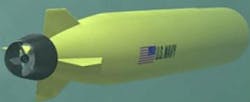Hamilton Sundstrand joins list of companies developing propulsion for long-endurance surveillance UUVs
ARLINGTON, Va., 5 Aug. 2012. The Hamilton Sundstrand Corp. Sea Systems segment, in Windsor Locks, Conn., is joining a growing list of unmanned underwater vehicle (UUV) experts that are developing advanced propulsion technologies to power future generations of U.S. Navy large, long-endurance UUVs on covert missions lasting for more than two months.
The Office of Naval Research (ONR) in Arlington, Va., awarded Hamilton Sundstrand an $18 million contract to develop energy section technology for the Navy's Large Displacement Unmanned Underwater Vehicle Innovative Naval Prototype (LDUUV INP) program.
For this contract, Hamilton Sundstrand researchers will concentrate on demonstrating energy-dense proton exchange membrane fuel cell (PEMFC)-based air-independent propulsion for a future generation of large, long-endurance surveillance UUVs.
PEMFC technology involves relatively low temperature and pressure ranges and a special polymer electrolyte membrane. This kind of fuel cell is considered to be a promising candidate to replace alkaline fuel cell technology.
The Navy's LDUUV INP program seeks to develop a large unmanned submarine able to operate in the open ocean and in coastal waters and harbors on missions lasting more than 70 days to gather intelligence, surveillance, and reconnaissance (ISR) information.
The LDUUV INP program will develop UUV autonomy and long-endurance propulsion systems for large UUVs that will provide 817 to 1,800 kilowatts of power, measure 120 inches long, and provide power for 46 to 70 days.
Hamilton Sundstrand joins General Atomics in San Diego; Lynntech Inc. in College Station, Texas; and NexTech Materials Ltd. in Lewis Center, Ohio, in this ONR project to develop advanced propulsion for future large UUVs.
The ONR contract to Hamilton Sundstrand was announced on 20 July. The contract to General Atomics, also announced on 20 July, is for a minimum of $25,000 and a maximum of $20 million. The Lynntech contract, announced in May, and the contract to NexTech, announced in June, each are for $18 million.
Hamilton Sundstrand Sea Systems has experience in undersea propulsion and weapon attitude control on systems such as the U.S. Mark 48 and Mark 50 torpedoes, as well as the United Kingdom Spearfish torpedo. The company also does work on electric propulsion systems such as closed- and open-cycle turbine engine designs, as well as gearboxes, pumps, electric generators, commercial aviation, condensers, valves, fuel metering assemblies, and electronic controllers.
In late April ONR officials announced plans to award a $5.9 million three-year contract to Hydroid Inc. in Pocasset, Mass., to develop an autonomy testing system for the LDUUV INP program.
For more information contact Hamilton Sundstrand Sea Systems online at www.hamiltonsundstrand.com/Space+Systems/Sea+Systems, or the Office of Naval Research at www.onr.navy.mil.
Follow Military & Aerospace Electronics and Avionics Intelligence news updates on Twitter
